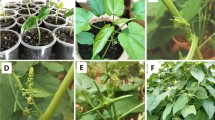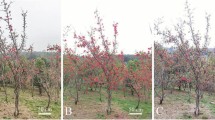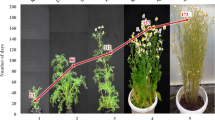Abstract
A comprehensive knowledge on reproductive traits is a prerequisite in utilizing the existing tea germplasm effectively for crop improvement to develop superior planting material for grower acceptance and market profitability. The Sri Lankan tea germplasm was characterized based on reproductive traits viz. floral morphology, pollen biology, stigma receptivity and phenology of flowering and fruit set. The variability in floral morphology, especially the style morphological features, formed phenotypic clines rather than distinct groups. Studies on pollen biology and stigma receptivity revealed significant variability and asynchrony that could result unequal reproductive success among the genotypes. Four distinct patterns were predictable among the genotypes based on flower and fruit abundance and the time of flowering and fruit set. Three well marked flowering periods occurred in February to April, July and in November. Nonetheless, major flowering period coincided February and March in all the genotypes allowing free crossing between the different genotypes. Profuse mature fruit crop was obtained in February to May. Approximately 26% success was achieved in tea controlled hybridization programmes. Fruits carry two seeds on average and became mature in 8–9 months after pollination. Zygotic development in tea takes more than 1 month after pollination and early embryonic development continued for 4 months after pollination. The indexing of the morpho-physiological diversity and the phenological calendars of flowering and fruit set made available in the study are of significant importance in effective utilization of the tea germplasm for crop improvement.












Similar content being viewed by others
References
Alexander MP (1969) Differential staining of aborted and non-aborted pollen. Stain Technol 41:117–122
Amarakoon T (2004) Tea for health. The Tea Research Institute of Sri Lanka, Talawakelle
Anandappa TI, Nanayakkara R, Solomom HR (1988) Seed-setting abilities of some Sri Lankan Tea clones and their implications for tea breeding. In: Sivapalan P, Kathiravetpillai A (eds) Proceedings of regional (scientific) conference. Tea Research Institute of Sri Lanka, Talawakelle, pp 73–87
Anonymous (2010) Tea market update of Ceylon Tea Board. 6(2):1
Banerjee B (1992) Botanical classification of tea. In: Wilson KC, Clifford MN (eds) Tea cultivation to consumption. Chapman and Hall, London, pp 25–51
Baruah DN (1989) Science and practice in tea culture. Tea Research Association, Jorhat, Calcutta
Bezbaruah HP (1975a) Development of flower, pollination and seed set in tea in north-east India. Two Bud 22(1):25–30
Bezbaruah HP (1975b) Inter-specific hybrids between tea (Camellia sinensis) and Wilson’s Camellis (C. irrawadiensis) morphology and cytology of F1 hybrids. Exp Agric 11:13–16
Bezbaruah HP, Saikia LR (1977) Variations in self and cross compatibility in tea (Camellia sinensis L.)—a summery of forty years pollination results at Tocklai. Two Bud 24(1):21–26
Egea J, Burgos L, Garcia JE, Egea L (1991) Stigma receptivity and style performance in several apricot cultivars. Sci Hortic 52:77–83
Helslop-Harrison Y, Shivanna KR (1977) The receptive surface of the angiosperm stigma. Ann Bot 41:1233–1258
Herrero M (1983) Factors affecting fruit set in “Aguade Aranjuez” pear. Acta Hortic 139:91–96
IPGRI (1997) Descriptors for tea (Camellia sinensis). International Plant Genetic Resource Institute, Rome
Iqbal MCM, Wijesekare KB (2002) Cells of the connective tissue differentiate and migrate into pollen sacs. Nturwissenchaften 89:39–42
Kapil RN, Bala-Sethi S (1963) Development of male and female gametophytes in Camellia sinensis (L.) O. Kuntze. Proc Natl Inst Sci India B 29:574–597
Kingdon-Ward F (1950) Does wild tea exist? Nature 165:297–299
Mattsson O, Knox RB, Helslop-Harrison J, Helslop-Harrison Y (1974) Protein pellicle of stigmatic papillae as a probable recognition site in incompatibility reactions. Nature 247:298–300
Muoki RC, Wachira EN, Pathak R, Kamunya SM (2007) Potential male gametophyte competition among Camellia sinensis genotypes in isolated bi-clonal seed orchards. Afr Crop Sci J 15(2):59–66
Neog B, Singh ID (2003) Study of floral biology of some cultivated tea (Camellia spp.) growing in the upper Assam region of north east India. J Plant Crops 31(1):50–52
Rodgers S (1975) Preliminary observation on pollen tube incompatibility in some tea clones. Tea Q 45(3 and 4):91–98
Sanzol J, Herrero M (2001) The “effective pollination period” in fruit trees. Sci Hortic 90:1–17
SAS (1985) SAS’s user’s guide: basic, 5th edn. SAS Inc., Cary
Sealy J (1958) A revision of the genus Camellia. Royal Horticultural Society, London
Sedgley M, Attanayake DPSTG (1988) The breeding system of rubber (Hevea brasiliensis): an evaluation of controlled hand pollination methods. Euphytica 39:83–91
Sethi S (1965) Structure and development of seed in Camellia sinensis (L.) O. Kuntze. Proc Natl Inst Sci India 31 B:25–33
Sharma VS, Mohanan M, Selvan AT (1981) Biology of flower of some tea (Camellia sp.) clones of south India. In: Vishveshwara V (ed) Proceedings of the fourth annual symposium on plantation crops. Indian Society for Plantation Crops, Kerala, pp 375–383
Shivanna KR, Johri BM (1985) The angiosperm pollen: structure and function. Wiley Eastern Ltd., New Delhi
Thirukkumaran G, Gunasekare MTK (2000) Nutrient medium for in vitro germination of tea (Camellia sinensis L.) pollen. Proceedings of Jaffna Science Association 8(1):37
Tsou CH (1997) Embryology of the Theaceae-anther and ovule development of Camellia, Frankilinia and Schima. Am J Bot 84:369–381
Wachira FN, Kamunya SM (2005) Pseudo-self-incompatibility in some tea clones (Camlleia sinensis (L.) O. Kuntze). J Hortic Sci Biotechnol 80(6):716–720
Weatherstone J (1992) Historical introduction. In: Wilson KC, Clifford MN (eds) Tea cultivation to consumption. Chapman and Hall, London, pp 1–23
Wickramarathne MR (1981) Variation in some leaf characteristics in tea (Camellia sinensis) and their use in the identification of tea cultivars. Tea Q Ceylon 50:183–189
Wickramaratne MR, Vitarana SI (1985) Insect pollination of tea (Camellia sinensis L.) in Sri Lanka. Trop Agric (Trinidad) 62(3):243–247
Wight W (1959) Nomenclature and classification of the tea plant. Nature 183:1726–1728
Wight W (1962) Tea classification revised. Curr Sci 31:298–299
Wight W, Barua DN (1957) What is tea? Nature 179:506–507
Williams RR (1970) Techniques used in fruit set experiments. In: Williams RR, Wilson D (eds) Towards regulating cropping. Grower Books, London, pp 57–61
Williams RR, Brain P, Church RM, Flook VA (1984) Flower receptivity pollen transfer and fruit-set variations during a single flowering period of Cox Orange Pippin apple. J Hortic Sci 59:337–347
Wu HK (1960) Embryogenesis in tea plant. Bot Bull Acad Sin Taipei 1(2):165–168
Yi W, Law SE, McCoy D, Wetzstein HY (2008) Stigma development and receptivity in almond (Prunus dulcis). Ann Bot 97:57–63
Acknowledgment
Authors acknowledge Mr. Rajika Gamage, Officer of the Photography Unit of the Tea Research Institute, Sri Lanka for technical assistance in photography.
Author information
Authors and Affiliations
Corresponding author
Rights and permissions
About this article
Cite this article
Ariyarathna, H.A.C.K., Gunasekare, M.T.K., Kottawa-Arachchige, J.D. et al. Morpho-physiological and phenological attributes of reproductive biology of tea (Camellia sinensis (L.) O. Kuntze) in Sri Lanka. Euphytica 181, 203–215 (2011). https://doi.org/10.1007/s10681-011-0399-9
Received:
Accepted:
Published:
Issue Date:
DOI: https://doi.org/10.1007/s10681-011-0399-9




